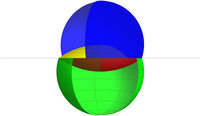Lens space

Okay kiddo, do you remember playing with magnifying glasses and how they would make things bigger or smaller? Well, when we talk about lens spaces, we're talking about a special shape that is kind of like a magnifying glass.
Imagine you have a flat piece of paper with a dot in the middle. Now, take that paper and bend it into a cone shape so the dot is in the very pointy top. If you look closely, you'll see that the paper is kind of stretching and getting bigger as you move towards the pointy top.
Now, let's take that cone and imagine we're looking at it from the side. If you look really closely, you'll see that the walls of the cone are curving in a specific way, like a spiral staircase. This curving and spiraling is what makes a lens space so special.
In math terms, a lens space is a three-dimensional shape that is made by "gluing" together the edges of a cone in a specific way. This is called "identifying" or "modding out" the edges of the cone. What you end up with is a space that is curved like a spiral staircase, but it loops back around on itself in a very specific way.
Scientists and mathematicians love lens spaces because they are what we call a "nontrivial" shape. This means that they have interesting and unique properties that can't be explained just by looking at regular, everyday objects. They're like a special type of puzzle that we get to explore and study to learn more about how the universe works.
So that's lens spaces in a nutshell, kiddo! They're like special, curving shapes that are made by glueing together the edges of a cone. And scientists love them because they're a cool puzzle to study and explore.
Imagine you have a flat piece of paper with a dot in the middle. Now, take that paper and bend it into a cone shape so the dot is in the very pointy top. If you look closely, you'll see that the paper is kind of stretching and getting bigger as you move towards the pointy top.
Now, let's take that cone and imagine we're looking at it from the side. If you look really closely, you'll see that the walls of the cone are curving in a specific way, like a spiral staircase. This curving and spiraling is what makes a lens space so special.
In math terms, a lens space is a three-dimensional shape that is made by "gluing" together the edges of a cone in a specific way. This is called "identifying" or "modding out" the edges of the cone. What you end up with is a space that is curved like a spiral staircase, but it loops back around on itself in a very specific way.
Scientists and mathematicians love lens spaces because they are what we call a "nontrivial" shape. This means that they have interesting and unique properties that can't be explained just by looking at regular, everyday objects. They're like a special type of puzzle that we get to explore and study to learn more about how the universe works.
So that's lens spaces in a nutshell, kiddo! They're like special, curving shapes that are made by glueing together the edges of a cone. And scientists love them because they're a cool puzzle to study and explore.
Related topics others have asked about:
